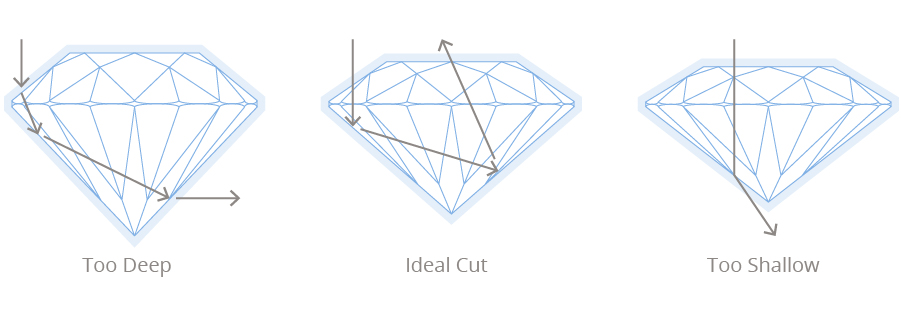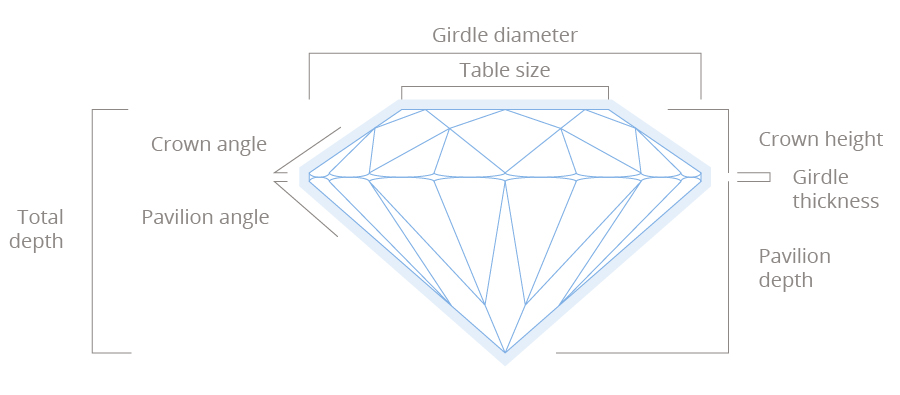Diamond Cut
Cut comes first
Cut has the biggest impact on the beauty of diamonds and the least amount of difference in their price. The word cut has several meanings when it comes to diamonds. The cut of a diamond does not just mean its shape (round brilliant, princess diamonds, oval diamonds, cushion diamonds, etc.) but also addresses the symmetry, polishing, angles and the proportions of each physical aspect of the diamond.

The cut determines the diamond’s sparkle. A properly cut diamond will refract the light that enters the diamond and return it through the top to produce the much desired sparkle. The angles have to be exactly right to effectively reflect the light back to your eye.
Difference in cutting
Diamonds are cut by different diamond cutters with different levels of skill. Each rough diamond crystal has its own distinct inclusions occurring at random locations. Diamond cutters are trying to cut the biggest and heaviest diamond from the rough crystal. Cutting diamonds to the best possible cut usually means losing diamond carat weight in the cutting process. There is always a compromise between beauty and size. Some cutters are better than others and are also willing to take the extra time to do it right.
The typical brilliant cut diamond is cut with 57 facets, 33 on the crown and 24 on the pavilion. On a well-proportioned stone, these facets will be uniform and symmetrical. If they are not, the diamond’s ability to refract and reflect light will suffer.

Warning: A poorly-cut diamond just won’t look right to the eye. Unfortunately, 75% of all rounds and 88% of all other shapes on the market are poorly proportioned.
When searching for a great cut, the two most important numbers are the depth percentage and the table percentage.
Table percentage is the length of the table divided by the width of the diamond. The higher the number, the bigger the table looks. The lower the number, the smaller the table looks. Do not confuse small table with small diameter. In general, you want the bigger diameter and the smaller table percentage for the most beautiful round diamonds.
Out of Round: It is interesting to note that “round” diamonds are usually not perfect circles. The length and width measurements for a round are both diameter measurements and will be different for an out-of-round shape. If the length is greater than the width by more than .10 millimeters, the diamond has not been cut well and should be avoided. For two-carat stones, the acceptable deviation is 0.12 millimeters.
Fancy Shape Cut
Probably the most important aspect for a fancy cut is the general appearance to your eye and that it is appealing and symmetrical. In many fancy shaped diamonds (marquise diamonds, pear diamonds, oval diamonds, emerald diamonds and heart shaped diamonds), the pavilion facets do not culminate at a point at the tip of the pavilion as they do for a round. Instead, they form an edge, called the “keel line.” This line should be centered in the diamond and this “culet” should still be as small as possible.
Girdle width will vary between greater extremes on some fancy shapes compared to the round brilliant. These include the marquise, pear and heart, where the girdle tends to be thick or extremely thick at the tips of the stone and in the cleft of the heart-shaped cut. Also, the princess cut, which has square corners, may have an extremely thin girdle in these areas. Since the girdles vary with greater frequency in fancy shapes, attention needs to be paid to extremely thin and extremely thick girdles to avoid danger of chipping or excessive weight.
























